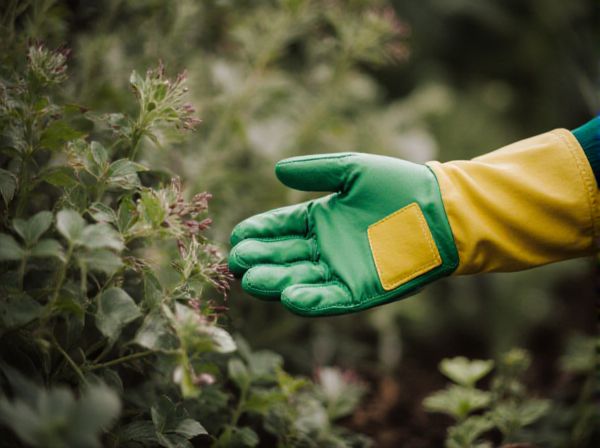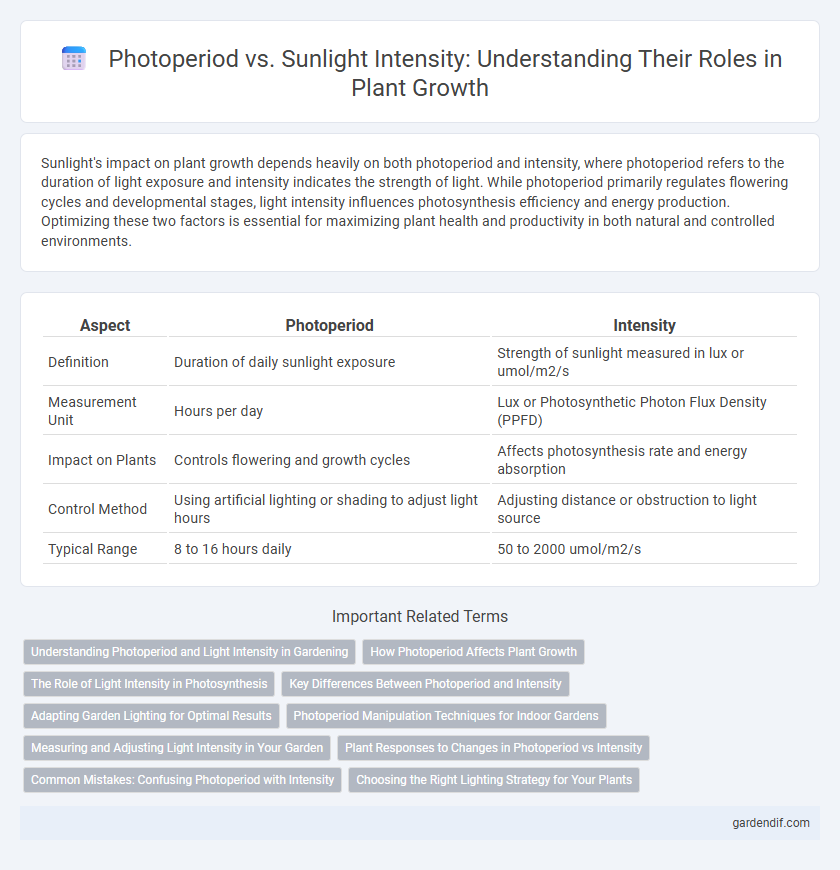
Photoperiod vs intensity Illustration
Sunlight's impact on plant growth depends heavily on both photoperiod and intensity, where photoperiod refers to the duration of light exposure and intensity indicates the strength of light. While photoperiod primarily regulates flowering cycles and developmental stages, light intensity influences photosynthesis efficiency and energy production. Optimizing these two factors is essential for maximizing plant health and productivity in both natural and controlled environments.
Table of Comparison
| Aspect | Photoperiod | Intensity |
|---|---|---|
| Definition | Duration of daily sunlight exposure | Strength of sunlight measured in lux or umol/m2/s |
| Measurement Unit | Hours per day | Lux or Photosynthetic Photon Flux Density (PPFD) |
| Impact on Plants | Controls flowering and growth cycles | Affects photosynthesis rate and energy absorption |
| Control Method | Using artificial lighting or shading to adjust light hours | Adjusting distance or obstruction to light source |
| Typical Range | 8 to 16 hours daily | 50 to 2000 umol/m2/s |
Understanding Photoperiod and Light Intensity in Gardening
Photoperiod refers to the duration of light exposure a plant receives within a 24-hour cycle, which significantly influences flowering and growth phases in gardening. Light intensity measures the strength of sunlight hitting the plant surface, affecting photosynthesis efficiency and overall plant health. Managing both photoperiod and light intensity optimizes growth conditions, ensuring plants receive adequate energy and appropriate cues for development.
How Photoperiod Affects Plant Growth
Photoperiod directly regulates plant growth by controlling the duration of light exposure, which influences flowering, leaf expansion, and biomass accumulation. Longer photoperiods typically promote vegetative growth in long-day plants, while short-day plants initiate flowering under reduced daylight hours. Understanding photoperiod sensitivity is critical for optimizing crop yield and growth cycles in horticulture and agriculture.
The Role of Light Intensity in Photosynthesis
Light intensity directly affects the rate of photosynthesis by influencing the energy available for chlorophyll to convert carbon dioxide and water into glucose. At low light intensities, photosynthesis is limited, but as intensity increases, the rate rises proportionally until other factors, like CO2 concentration or temperature, become limiting. High light intensity enhances the production of ATP and NADPH during the light-dependent reactions, driving the Calvin cycle more efficiently for plant growth.
Key Differences Between Photoperiod and Intensity
Photoperiod refers to the duration of sunlight exposure within a 24-hour period, which regulates plant developmental processes like flowering and dormancy. Intensity measures the strength or concentration of sunlight, impacting photosynthesis efficiency and energy absorption by plants. Key differences lie in photoperiod controlling timing and biological rhythms, whereas intensity influences growth rate and photosynthetic yield.
Adapting Garden Lighting for Optimal Results
Photoperiod and light intensity are crucial factors in adapting garden lighting for optimal plant growth and flowering. Tailoring the photoperiod to mimic natural day lengths enhances photosynthesis and triggers flowering cycles, while adjusting light intensity ensures plants receive adequate energy without causing stress or photoinhibition. Utilizing LED grow lights with customizable timers and dimmers allows gardeners to precisely control both duration and intensity, promoting healthy, vigorous growth and maximizing yield.
Photoperiod Manipulation Techniques for Indoor Gardens
Photoperiod manipulation techniques in indoor gardens involve controlling the duration of light exposure to regulate plant growth cycles, optimize flowering, and improve crop yields. Techniques such as using programmable LED grow lights or automated timers allow precise adjustment of light periods, simulating natural day lengths or inducing specific growth responses. Understanding the balance between photoperiod and light intensity maximizes photosynthesis efficiency while preventing plant stress.
Measuring and Adjusting Light Intensity in Your Garden
Measuring light intensity in your garden involves using a PAR (Photosynthetically Active Radiation) meter or a lux meter to quantify the amount of usable light plants receive, which directly impacts photosynthesis efficiency. Adjusting light intensity can be achieved by altering plant placement, using shade cloths, or installing supplemental grow lights that mimic natural sunlight spectra. Balancing photoperiod and light intensity ensures optimal growth cycles, promoting healthier plants and better yields.
Plant Responses to Changes in Photoperiod vs Intensity
Plants adjust growth and flowering patterns primarily based on photoperiod changes, with longer or shorter day lengths triggering hormonal shifts that regulate developmental phases. Light intensity influences photosynthetic rates and biomass accumulation, directly affecting plant vigor but less so flowering timing compared to photoperiod. Photoperiod sensitivity genes modulate circadian rhythms, while intensity impacts chlorophyll production and stomatal conductance, highlighting distinct but complementary roles in plant adaptation.
Common Mistakes: Confusing Photoperiod with Intensity
Confusing photoperiod with light intensity is a common mistake that can negatively impact plant growth and development. Photoperiod refers to the duration of light exposure within a 24-hour cycle, influencing flowering and circadian rhythms, while intensity denotes the strength or brightness of the light source, affecting photosynthesis efficiency. Understanding the distinct roles of photoperiod and intensity ensures accurate cultivation practices and optimal plant health.
Choosing the Right Lighting Strategy for Your Plants
Selecting the ideal lighting strategy for plants hinges on understanding photoperiod and light intensity differences, where photoperiod dictates the duration of light exposure affecting flowering and growth cycles. Light intensity influences photosynthesis efficiency and overall plant vigor, requiring adjustments based on species-specific light tolerance and developmental stages. Balancing both factors optimizes plant health, ensuring proper metabolic function and maximizing yield in controlled environments.
Photoperiod vs intensity Infographic

 gardendif.com
gardendif.com